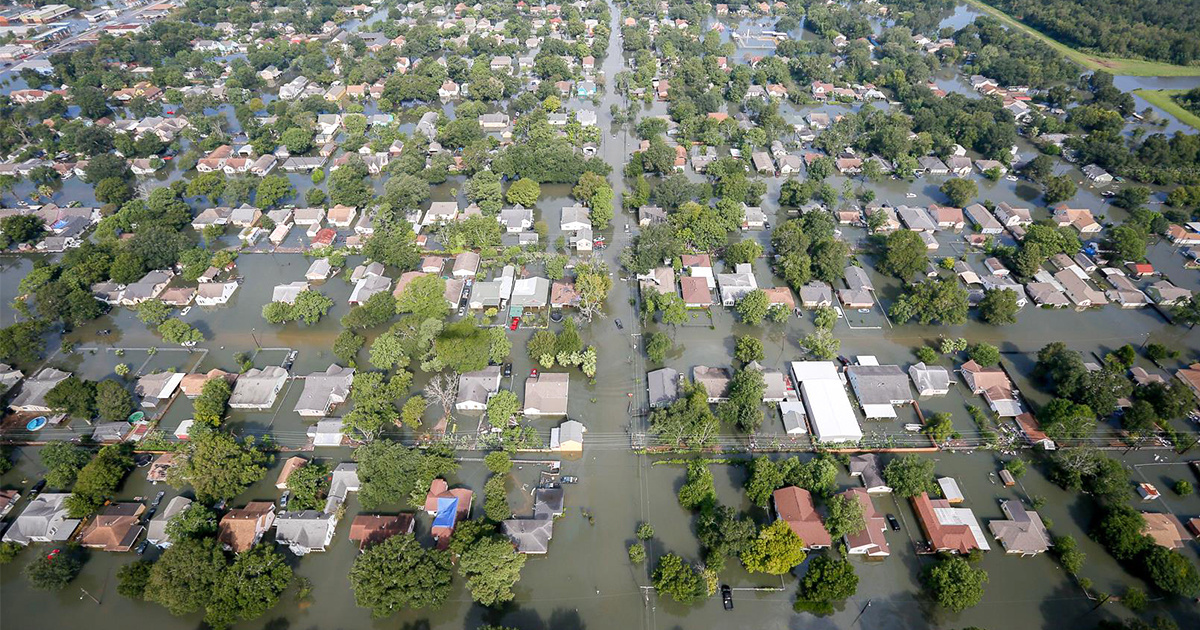
Investigation Reveals Trump Admin’s ‘Disturbing’ Disregard for Data, Science, Public Health and Environment After Hurricane Harvey

By Andrea Germanos
President Donald Trump‘s U.S. Environmental Protection Agency (EPA) and Texas state officials rejected an offer from NASA scientists in 2017 to use their state-of-the-art flying laboratory to evaluate air quality in Houston after Hurricane Harvey, new reporting by the Los Angeles Times reveals.
“This is disturbing,” said Lina Hidalgo, judge for Texas’s Harris County.
Harvey brought historic rainfall, catastrophic flooding and triggered potentially dangerous environmental and public health impacts: Houston’s many refineries and petrochemical released pollutants into the air and waters, and area residents began to complain of worrisome smells and toxic sights near the facilities, as well as symptoms including headaches. The EPA asserted that the air quality posed no threat.
NASA, it turned out, was in a good position to gather data on air quality in the area with its DC-8. The jet, whose ability to ability to gather data dwarfs that of the EPA’s air pollution plane or the hand-held devices used by Texas state officials, was already set up for testing because of a scheduled six-hour test flight to Lamont, Oklahoma on Sept. 14.
The response to NASA’s offer? Thanks but no thanks.
Susanne Rust and Louis Sahagun reported for the Times:
On Sept. 9, David Gray, the EPA’s deputy regional administrator in Texas and leader of the agency’s emergency response, wrote to NASA and Texas officials that he was “hesitant” to have the jet “collect additional information that overlaps our existing efforts” until he learned more about the mission. He noted that media and nongovernmental organizations were releasing data that was “conflicting” with the state and EPA’s.
The NASA scientists offered assurances that their fact-finding would not get in the way, but noted that the data would eventually be seen by the public. Texas and the EPA were unmoved.
The state-level response came from director of toxicology Michael Honeycutt, who now heads EPA’s Science Advisory Board and is known for expressing views well out of the reach of mainstream science, such as the idea that lowering ozone would be bad for public health.
On Sept. 11, Honeycutt wrote in an email to NASA and EPA officials that state data showed no sign for concern, and “we don’t think your data would be useful for source identification while industry continues to restart their operations.”
Gray agreed with Honeycutt: “EPA concurs with your assessment and we will not plan to ask NASA to conduct this mission.”
Associated Press reporter Frank Bajak noted that the new investigation adds weight to his own news agency’s previous reporting showing that “Texas environmental regulators had little interest in exposing most post-Harvey industrial contamination.”
Reacting to the reporting on Twitter, Dr. Chelsea Thompson, a research scientist in atmospheric chemistry, wrote, “It’s worth noting that, over a year later now, all of us involved are still stunned by how this played out.”
This is an important story from the @latimes. I was on the #NASA_ATom mission when Harvey hit and we wanted to fly the area to assess the air quality, esp. given the industrial spills/leaks from the flooding. We were told that we were not welcome. https://t.co/LdbpGjufjE
— Dr. Chelsea Thompson ❄️ (@ArcticAirDoctor) March 5, 2019
Another scientist, air pollution expert Nick Vizenor, who said he was part of lab team preparing for the potential mission over Houston, said the new investigation shows the “EPA and the state of Texas did not want to have all the information it could to try and help and protect the citizens of Houston.”
“This is yet another story that shows how little the current administration cares about [its] citizens and the environment,” he said.
This is an important story, I wasn't scheduled to be on this flight, but I was in the lab, where it was all hands on deck, rushing to prep extra air sampling canisters for what would have been a very timely and poignant mission.https://t.co/CR5eCbgm7K
— Nick Vizenor (@Nick_chem) March 5, 2019
While this story doesn't answer all of those questions, it certainly makes things much more clear. The EPA and the state of Texas did not want to have all the information it could to try and help and protect the citizens of Houston.
— Nick Vizenor (@Nick_chem) March 5, 2019
“EPA and the Texas Commission on Environmental Quality knew air pollution was one of the unseen dangers of Hurricane Harvey, but according to news reports they deliberately chose not to use every available tool to discover it,” added Elena Craft, senior health scientist with Environmental Defense Fund. “Their rejection of NASA’s plan to fly a pollution-spotting plane over Houston after the storm is an abdication of responsibility and part of a disturbing trend of willful ignorance.”
“Their action,” she continued, “caused unnecessary risk to the health and safety of Texas families.”
Trump Wants to Eliminate NASA’s Climate Research Programs: These Pictures Show What a Loss That Would Be – EcoWatch https://t.co/UT5M90yQVv
— Aidan Gallagher (@AidanRGallagher) March 30, 2018
Reposted with permission from our media associate Common Dreams.

 233k
233k  41k
41k  Subscribe
Subscribe 